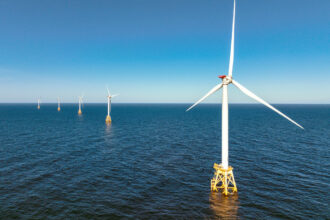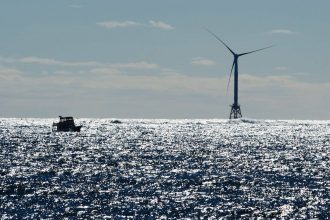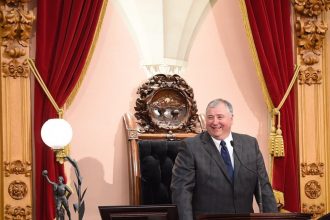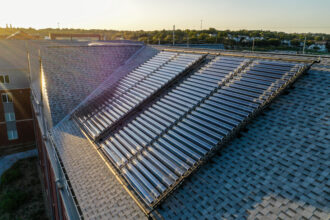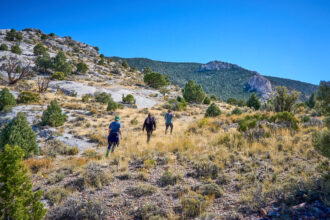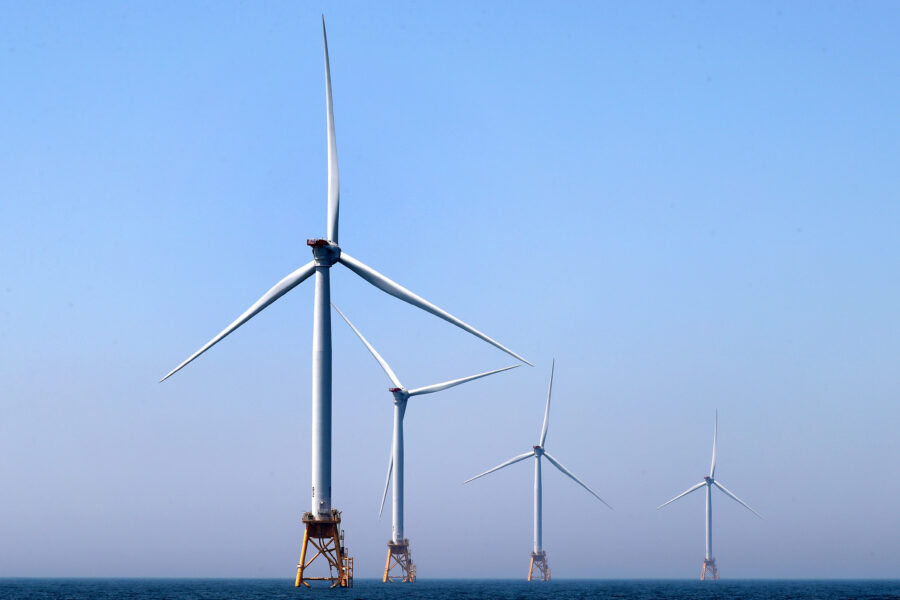On Dec. 8, after 14 years of small victories and larger setbacks, the remnants of the company behind Icebreaker Wind announced the indefinite suspension of what was once set to be the first offshore wind farm built in the Great Lakes.
The decision by the Lake Erie Energy Development Corporation (LEEDCo) to “temporarily halt” the project came as little surprise to those who had been following it. Icebreaker was the only project of its kind to come close to fruition. But it had barely survived a stream of legal disputes and permitting delays that put it many years behind schedule, and was still nowhere near having turbines in the water.
“The writing’s been on the wall for a long time,” said Richard Stuebi, who headed the project from its inception in 2009 until the first official president took over in 2010. “And just more and more scribbles in darker and darker ink have been added over the past decade or so.”
One of the biggest sources of concern over the years was the possibility that the U.S. Department of Energy, unsatisfied with LEEDCo’s halting progress, would revoke the $50 million in federal funding that kept the nonprofit’s sole project viable. In the end, that’s what happened.
“DOE is in the process of terminating the grant,” Will Friedman, president and CEO of the Cleveland-Cuyahoga County Port Authority and LEEDCo’s acting president, said in an email. “Technically,” he added, “it is a mutual termination by LEEDCo and DOE because LEEDCo is unable to meet grant performance milestones.”
LEEDCo had about $37 million left, most of which it planned to save for construction. Now that grant money is gone. The developer stopped short of canceling the project, saying in a press release that it is “still exploring various avenues that might allow the project to move forward in the future.” It didn’t specify what would have to change for work to resume.
Early Troubles
Icebreaker Wind was intended to be a demonstration project. Had permitting gone according to plan, its six turbines might already be anchored to the bed of Lake Erie, eight miles off the coast of Cleveland, generating barely more than 20 megawatts of electricity all together—130 times less than the capacity of Ohio’s largest coal plant.
When Stuebi stepped up in 2009 to helm LEEDCo, he was hopeful that the wind farm could be completed within a few years, despite the challenges he knew lay ahead. Before long, however, it became clear that “absent some sort of massive sea change in circumstances, this project was always going to be facing opposition and obstacles and impediments” that would make it difficult to complete, he said.
Icebreaker “was speculative and aspirational,” Stuebi said. That made it inherently risky. He still believed it was worth pursuing.
Stuebi ran LEEDCo on a part-time basis during its first year. Lorry Wagner, the nonprofit’s first full-time president, stayed for almost a decade. The early years were the most hopeful, Wagner said. Bechtel Corporation and General Electric, a pair of engineering powerhouses, signed on to build Icebreaker. “And when you have Bechtel with you, you kind of feel pretty good,” he said.
But it was under Wagner’s leadership that the problems began to pile up. Shortly after he took over, Ohio’s last Democratic governor, Ted Strickland, left office and was replaced by an administration markedly less enthusiastic about renewables, dashing LEEDCo’s hopes of getting any funding from the state. Bechtel and GE soon pulled out of the project. By the middle of 2012, LEEDCo was contemplating shutting it down.
In a last-ditch push to save its wind farm, LEEDCo applied for a grant from the DOE. It triumphed in the first of multiple rounds of funding, walking away with several million dollars, but didn’t make it through the second.
“So here we are, in June of 2014, we lost, we don’t have a ton of money left, and I remember that was the second-lowest point for me at Icebreaker,” Wagner said. “The lowest point was at the end. But I didn’t know how we were going to go forward.”
Then the DOE gave Icebreaker another chance. In 2016, the company secured a total of $50 million in federal support, and “we had a real project,” Wagner said. But that was when the dark cloud settled over Icebreaker, he added, “although we always knew something was wrong.”
This story is funded by readers like you.
Our nonprofit newsroom provides award-winning climate coverage free of charge and advertising. We rely on donations from readers like you to keep going. Please donate now to support our work.
Donate NowCompounding Crises
Icebreaker faced pushback almost from the beginning. The turbines would be visible from the shore, and some of its prospective neighbors didn’t want to see them. Birding groups worried about what the blades would do to migrating species. Still others, conscious of the lake’s polluted history, feared that its recovering ecosystems would be overtaken by wind turbines.
“Icebreaker and then the follow-on projects would be turning Lake Erie into a heavy industry energy project, no different in our eyes than if someone were proposing a coal-fired energy plant, or gas, or nuclear,” said John Lipaj, a board member for the nonprofit Lake Erie Foundation, in August. (“It just wasn’t right for a resource as precious as Lake Erie,” he added on Friday.)
As LEEDCo started to apply for the many permits its project required, the lawsuits piled up, and the line blurred between ordinary local opposition and something more sinister. Two of its legal challengers had their bills paid by a coal company. Others had ties to anti-renewable groups.
Wagner, who left LEEDCo in 2019, suspects that Icebreaker fell victim to the Ohio utility bribery scandal that came to light in 2020. The project stalled that year after the Ohio Power Siting Board tacked an unexpected set of restrictions onto a key permit. The board was chaired at the time by Sam Randazzo, a former energy lobbyist who surrendered at the U.S. District Court in Cincinnati Monday on charges of bribery and embezzlement.
Under Dave Karpinski, LEEDCo’s second and final full-time president, the nonprofit successfully pushed the Ohio Power Siting Board to reconsider the restrictions on its permit. Then Karpinski left and was not replaced. Even though LEEDCo emerged victorious from its court cases and hearings, it never recovered from the delays they caused.
Friedman, who kept Icebreaker alive during its last active years, said in July that he’s unsure how long it’ll take for another proposed wind farm to follow Icebreaker—or if any ever will.
“From a technological standpoint, I’m very certain you can generate electricity out here in the Great Lakes,” he said. “You could overcome icing and winter conditions and freshwater and all that. But I don’t know whether, politically and otherwise, it’s going to happen.”







